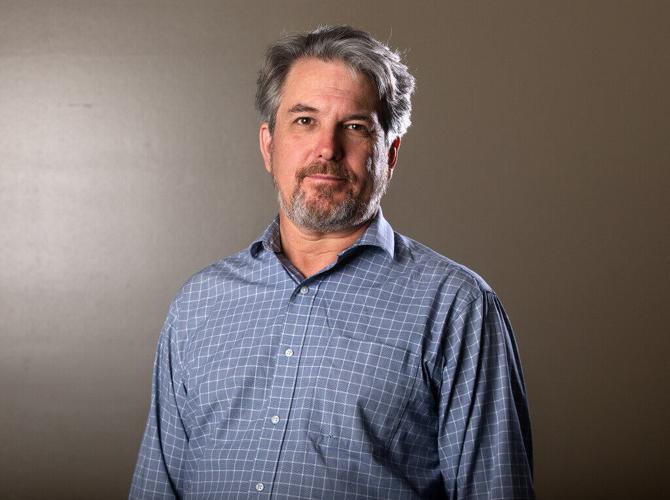You don’t have to look at footage of flood-destroyed towns in North Carolina to see evidence of our overheating climate.
In Tucson, you just have to walk outside.
After a brief flirtation with mild weather in mid-September, we’ve been broiling in a summer furnace far outside our climatic norms for the last 10 days or so.
The last week we’ve experienced an unprecedented run of heat: Seven straight days of record highs through Tuesday. And Tuesday was also the hottest October day ever recorded in Tucson, at 105 Fahrenheit, two degrees hotter than the previous record set on Oct. 1 and Oct. 2, 2020.
It’s normal for people to be disappointed with how hot it remains in Tucson during September and early October. But this has been shockingly extreme, as well as depressing.
If we can’t expect mild afternoons this time of year, then we should be able to expect cool mornings. But this year even that small consolation has been elusive.

Arizona Daily Star columnist Tim Steller
I was up hiking in the Santa Rita Mountains early Sunday. Even there, as my companions and I walked from about 5,200 feet well up above 7,000 feet there was little respite. Hiking through the shady forest, my companions and I only passed through a couple of pockets of cool air in the hour before 9 a.m.
After 9 a.m., it was just plain warm. Above 7,000 feet. In late September.
When similarly abnormal heat hit in July 2023, national reporters descended on Phoenix to question the livability of the place. That led to a widespread mocking response from Republican politicos, who noted Arizona is always hot in the summer.
They aren’t saying that anymore: It was 117 degrees in Phoenix on Sept. 28 — exceptionally hot for any time of year, but unprecedented during the period when there aren’t even 12 hours of daylight to help temperatures rise.
Of course, we were warned this was coming. Late last century and all through the early 2000s, stories in this newspaper warned of a hotter future in the Southwest if we didn’t drastically curb humanity’s burning of fossil fuels. The resulting greenhouse gases trap heat in Earth’s atmosphere and warm the climate.
University of Arizona scientists contributed to some of the many forecasts we’ve covered, including one published in 2003.
“Climate models used in the study predict the region’s average temperature will rise 4 to 5 degrees Fahrenheit by 2030, and 7 to 12 degrees Fahrenheit by 2090,” a 2003 Star story warned.
The world we forecasted a mere 20 years ago is already the one we’re living in.
I sat in on a web-based briefing Tuesday morning about “attribution science,” which is the science of calculating whether and how much to attribute extreme weather to human-caused climate change. It’s a process that relies on the calculation of the changes in probabilities of extreme weather due to human activities.

Tucson set seven days of record high temperatures through Oct. 1, 2024. It's the climatic future that experts have been warning us about.
Climate Central, the host of that briefing, calculates that humans’ activities have caused a regional average of 25 additional “risky heat days” per year in the Southwest. These are days hotter than 90% of the temperatures recorded from 1991-2020, when the risk of heat-related death jumps.
Through August this year, the Pima County Medical Examiner has recorded 25 heat-caused deaths among people who weren’t border-crossers. But unlike most years, this year’s tally may continue deep into September and October, thanks to the current wave.
The mechanism for our, and the world’s, multiplying extreme heat waves is stubborn high-pressure ridges. Tuesday I called up climatologist Chris Castro, who left the University of Arizona, for a refresher on the concept.
“When you get heat waves, it’s due to these big ridges of high pressure in the atmosphere,” said Castro, now a director at the National Center for Atmospheric Research in Boulder, Colorado. “Those ridges are getting larger and more intense. When they do, there’s greater propensity for air to sink. It stabilizes the atmosphere.”
These “blocking patterns” are more common in our heated world, and take longer to break down.
Now, of course, some people are in denial about this, or are perhaps bought and paid for by the fossil-fuel industry. Republican Donald Trump calls climate change a “hoax” and points to increased fossil-fuel production as the solution to inflation and other ills. You can expect rollbacks of every possible anti-climate-change policy if he’s elected.
Even Democrat Kamala Harris has been moderately friendly to fossil fuels. She’s changed her opinion on hydraulic fracturing — “fracking” — and now supports it as a way to get oil and gas from underground. And under the Biden administration, U.S. oil production has reached new all-time records repeatedly this year.
But the administration did get the Inflation Reduction Act passed, a bill that, despite its name, was largely a climate bill. It subsidizes companies that move away from emitting greenhouse gases, among other things.
And the Sunrise Movement, which protested Democrats’ relative quiet about climate change earlier this summer, praised Harris’ new economic plan for its climate components last week. Among other things, the plan would extend the incentives for decarbonizing heavy industries such as cement, steel and fertilizer manufacturing.
The Sunrise Movement is a young people’s activist organization against climate change. And one thing about them is certainly right: We ought to be thinking about their generation, not the older ones that I and many of you belong to, when we vote.





